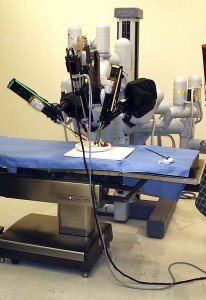Small, fiber optic telescopes can be used to look into the internal “plumbing” of the urinary tract, including all the way up into the kidney. These scopes, which follow the body’s natural passages, allow the use of lasers, baskets and other instruments to treat stones, tumors, or other problems.
Recovery is significantly quicker than in traditional open surgery that would have had to cut muscle to reach these same spaces.
(Endoscopy surgery is performed at our Poughkeepsie location)
At Premier Medical Group Urology Division we continue to provide our patients with the latest technology, such as the da Vinci® robotic surgical system.

Dr. Naeem Rahman and Dr. Walter Parker both specialize in the robotic surgery of the prostate. They see patients in the Kingston, Fishkill and Poughkeepsie locations.
Dr. Praneeth Vemulapalli and Dr. Jaspreet Singh, also specialize in robotic surgery of the prostate and see patients in the Newburgh location.
Dr. Daniel Katz uses the robotic surgical system for vaginal prolapse repair, and Dr. Paul Pietrow utilizes the robotic surgical system for kidney stone disease.
The da Vinci® Surgical System is a sophisticated robotic platform designed to expand the surgeon’s capabilities. Patients benefit from the potential for significantly less pain, a shorter hospital stay, and faster return to normal daily activities – as well as the potential for better clinical outcomes. It is important to know that surgery with da Vinci® does not place a robot at the controls; your surgeon is controlling every aspect of the surgery. At the same time, state of the art robotic and computer technologies scale, filter, and flawlessly interpret your surgeons hand movements into the precise micro-movements of the da Vinci® instruments.

The da Vinci® Surgical System is today’s number one choice for both men and their doctors for the treatment of prostate cancer. This minimally invasive surgery has many benefits including better outcomes.
The benefits of robotic surgery include:
Laparoscopic surgery is a technique that utilizes thin instruments and a lighted telescope to look and work inside of the abdominal cavity.
Laparoscopy uses multiple small incisions, each about a quarter to one half of an inch. These holes allow us to pass instruments – such as scissors, staplers, sutures and graspers – as well as the telescope connected to a light source and a camera. Carbon dioxide gas is used to fill the belly cavity and to create enough space to see and operate.
In most cases, a laparoscopic approach can be used instead of an open surgery that would require a much larger, more painful incision. For example, a partial kidney removal would use 4 small incisions in the front of the abdomen while an open surgery would use a 10 inch incision on the patient’s side or flank. Laparoscopy can be less stressful for the patient, it increases the surgeon’s ability to see what they are working on, it decreases blood loss, all while causing less pain. These advantages all translate into a quicker recovery and a significantly shorter hospital stay compared to open surgery. This then allows the patient to heal faster and return to work and/or normal activities more quickly.
While this technique was first used by the general surgeons to remove gall bladders in the 1980s, urologists began to perform laparoscopic kidney surgery in 1992. Since then, the vast majority of kidney and prostate surgery is performed with laparoscopy and only a small portion requires an open approach. Many urinary tract conditions can be treated with laparoscopy. However, not everyone is a candidate for laparoscopic surgery.
Laparoscopy is performed in a hospital. You will be given an IV line with medication and general anesthesia. Three to five small incisions are made in your abdomen. Then laparoscopic instruments are positioned in the incisions. Your abdomen is filled with a harmless gas to inflate it so the doctor can more easily view your organs. These tiny incisions will be closed with tape, stitches or staples. You could stay in the hospital for a day or two or go home the same day of the procedure.
The pain is generally nominal. You may feel shoulder pain from the gas that was used to inflate the stomach. The nurses will give you pain medication if needed. Walking around will help alleviate the gas pains and also helps prevent blood clots.
When you go home, you should take it easy and follow the doctor’s instructions such as no bathing or swimming for 2 weeks. Call your doctor if you contract a fever, redness around the incisions, bleeding, severe pain, nausea, vomiting, swelling or pain in your legs.
Whether it’s a prostatectomy, kidney stone, testicular cancer, or any number of abdominal procedures, even minimally invasive surgeries can have really big stakes. Trust your health with our skilled and experienced doctors.
Dr. Naeem Rahman and Dr. Walter Parker both specialize in laprascopic surgery. They see patients in the Kingston, Fishkill and Poughkeepsie locations.
Dr. Praneeth Vemulapalli and Dr. Jaspreet Singh, also specialize in laprascopic surgery and see patients in the Newburgh location.
